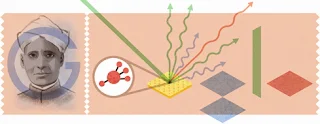NEW DELHI: Google on Thursday celebrated CV Raman's 125th birthday by dedicating a doodle on its homepage that shows his portrait along ...
NEW DELHI: Google on Thursday celebrated CV Raman's 125th birthday by dedicating a doodle on its homepage that shows his portrait along with light rays emitting from a source.
The doodle is available only on Google India pages. It also appears on the homepage of Google Chrome users in India.
Born on November 7, 1888, in Trichinopoly in Madras province (in British India), Sir Chandrasekhara Venkata Raman was a renowned physicist who made significant contributions to the growth of science.
His interest in physics developed early. Pursuing his passion, CV Raman won the gold medal in physics in 1904 and passed his BA examination securing first place. He completed his MA in 1907 with distinctions.
CV Raman continued his research at IACS after joining the Indian Financial Service as an assistant auditor general for the government of India in 1907.
He established the Raman Research Institute (RRI) in 1948 entirely on his own without accepting a penny from the government. There was no electricity at RRI in the first year, but that did not deter Raman from conducting several optical experiments with sunlight, a few lenses and a pair of polaroids. He considered a beam of sunlight as the best source. A manually-operated heliostat, kept in operation by voice communication, produced astonishing results.
Science was a living religion for CV Raman and his work on the scattering of light and the discovery of the Raman Effect, won him the Nobel Prize in 1930, making him the first Asian and first non-white to receive any Nobel Prize in the sciences.
To pay tribute to this unique mind, the nation observes National Science Day on February 28.
CV Raman died on November 21, 1970 in Bangalore.
Source : http://timesofindia.indiatimes.com/








COMMENTS